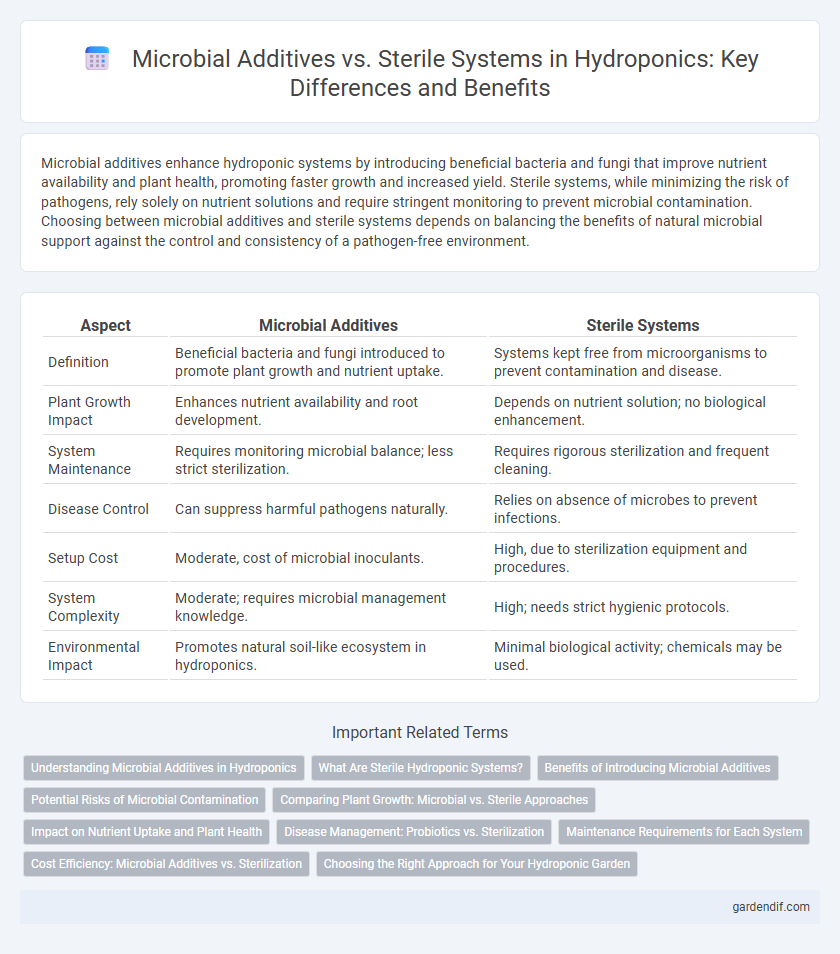
Microbial Additives vs Sterile Systems Illustration
Microbial additives enhance hydroponic systems by introducing beneficial bacteria and fungi that improve nutrient availability and plant health, promoting faster growth and increased yield. Sterile systems, while minimizing the risk of pathogens, rely solely on nutrient solutions and require stringent monitoring to prevent microbial contamination. Choosing between microbial additives and sterile systems depends on balancing the benefits of natural microbial support against the control and consistency of a pathogen-free environment.
Table of Comparison
| Aspect | Microbial Additives | Sterile Systems |
|---|---|---|
| Definition | Beneficial bacteria and fungi introduced to promote plant growth and nutrient uptake. | Systems kept free from microorganisms to prevent contamination and disease. |
| Plant Growth Impact | Enhances nutrient availability and root development. | Depends on nutrient solution; no biological enhancement. |
| System Maintenance | Requires monitoring microbial balance; less strict sterilization. | Requires rigorous sterilization and frequent cleaning. |
| Disease Control | Can suppress harmful pathogens naturally. | Relies on absence of microbes to prevent infections. |
| Setup Cost | Moderate, cost of microbial inoculants. | High, due to sterilization equipment and procedures. |
| System Complexity | Moderate; requires microbial management knowledge. | High; needs strict hygienic protocols. |
| Environmental Impact | Promotes natural soil-like ecosystem in hydroponics. | Minimal biological activity; chemicals may be used. |
Understanding Microbial Additives in Hydroponics
Microbial additives in hydroponics introduce beneficial bacteria and fungi that enhance nutrient uptake, promote root growth, and suppress plant pathogens, thereby improving crop health and yield. Unlike sterile systems, which rely solely on nutrient solutions without microbial presence, microbial additives create a dynamic environment that supports plant-microbe interactions essential for optimal plant development. These additives often contain specific strains like Bacillus subtilis and Trichoderma spp., which contribute to nutrient cycling and disease resistance in hydroponic setups.
What Are Sterile Hydroponic Systems?
Sterile hydroponic systems eliminate all microbial presence by using sterilized water, nutrient solutions, and growing media to prevent contamination and disease. These systems rely on strict sanitation protocols and closed environments to maintain pathogen-free conditions, ensuring plants are grown in a controlled, microbe-free setting. By minimizing microbial activity, sterile hydroponic systems reduce the risk of root diseases and promote uniform plant growth, though they may lack the beneficial interactions provided by microbial additives.
Benefits of Introducing Microbial Additives
Introducing microbial additives in hydroponic systems enhances nutrient availability by promoting nutrient cycling and improving root absorption efficiency. These beneficial microbes help suppress harmful pathogens, reducing the need for chemical treatments and fostering a healthier root environment. Enhanced microbial activity supports plant growth, leading to higher yields and improved crop quality compared to sterile systems.
Potential Risks of Microbial Contamination
Microbial additives in hydroponic systems introduce beneficial bacteria and fungi that can enhance nutrient uptake and plant growth, yet they carry the potential risk of introducing pathogenic microbes leading to contamination. Sterile hydroponic systems minimize microbial presence to reduce these risks but can result in nutrient imbalances and compromised plant health due to the absence of symbiotic microorganisms. Monitoring microbial populations and maintaining strict sanitation protocols are essential to prevent the proliferation of harmful pathogens and ensure system stability.
Comparing Plant Growth: Microbial vs. Sterile Approaches
Microbial additives in hydroponic systems enhance nutrient uptake and promote robust plant growth by fostering beneficial microbial communities that improve root health and nutrient cycling. In contrast, sterile systems rely solely on nutrient solutions without microbial interactions, often resulting in slower growth and reduced resilience against pathogens. Research consistently shows that plants grown with microbial additives achieve higher biomass and better overall development compared to those in sterile hydroponic environments.
Impact on Nutrient Uptake and Plant Health
Microbial additives in hydroponic systems enhance nutrient uptake by promoting beneficial microbial activity that breaks down organic matter, releasing essential nutrients and improving root health. Sterile systems prevent pathogen introduction but may limit nutrient availability and microbial symbiosis, potentially reducing nutrient absorption efficiency. Integrating targeted microbial inoculants can optimize plant health and nutrient uptake, balancing disease prevention with growth promotion.
Disease Management: Probiotics vs. Sterilization
Microbial additives in hydroponic systems introduce beneficial probiotics that enhance disease resistance by outcompeting pathogens and promoting plant immune responses. In contrast, sterile systems rely on complete sterilization to eliminate all microbes, reducing disease risk but potentially hindering beneficial microbial interactions essential for plant health. Probiotic use fosters a dynamic microbial community that helps suppress diseases naturally, while sterilization requires strict environmental controls to prevent pathogen reintroduction.
Maintenance Requirements for Each System
Microbial additives in hydroponic systems promote beneficial bacteria and fungi that enhance nutrient availability and plant health, requiring careful monitoring of microbial balance and periodic replenishment to maintain effectiveness. Sterile hydroponic systems demand rigorous sanitation protocols to prevent contamination, including frequent cleaning and sterilization of equipment and nutrient solutions to uphold a pathogen-free environment. Overall, microbial additive systems involve ongoing biological management, whereas sterile systems focus on strict hygiene and preventative maintenance to sustain optimal growing conditions.
Cost Efficiency: Microbial Additives vs. Sterilization
Microbial additives in hydroponic systems reduce operational costs by enhancing nutrient availability and promoting plant growth without expensive chemical treatments. Sterile systems require constant investment in sterilization equipment and chemicals, increasing maintenance expenses significantly. Incorporating beneficial microbes offers a cost-efficient alternative by naturally supporting plant health and minimizing the need for harsh sterilization processes.
Choosing the Right Approach for Your Hydroponic Garden
Microbial additives enhance nutrient availability and promote plant health by introducing beneficial bacteria and fungi into hydroponic systems, improving root development and disease resistance. Sterile systems, in contrast, rely on strict sanitation to prevent pathogen introduction, minimizing contamination risks and ensuring precise control over nutrient solutions. Selecting the right approach depends on crop type, system scale, and management preference, balancing the benefits of microbial interaction against the predictability of sterile environments.
Microbial Additives vs Sterile Systems Infographic

 gardendif.com
gardendif.com